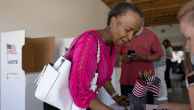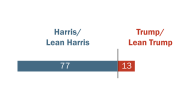Along with conducting a survey of public attitudes toward political engagement and activism on social media, the Center also performed a separate analysis of several Twitter hashtags. First, it examined the volume of tweets using the #BlackLivesMatter hashtag and other hashtags related to issues, causes or news events to see how usages differ over time and across issue areas. Second, it conducted a content analysis of the topics that are most often mentioned in conversations around the #BlackLivesMatter, #BlueLivesMatter and #AllLivesMatter hashtags during major news events.
The #BlackLivesMatter hashtag has been a relatively consistent presence on Twitter for the last five years, with periodic increases in usage around key events
The #BlackLivesMatter hashtag first appeared on Twitter five years ago in July 2013 following the acquittal of George Zimmerman in the shooting death of Trayvon Martin. From July 2013 through May 1, 2018, the hashtag has been used nearly 30 million times on Twitter, an average of 17,002 times per day, according to a Pew Research Center analysis of public tweets using Crimson Hexagon software. Although the hashtag was slow to gain prominence, there have been periodic increases in its daily usage in response to real-world events – most notably news and discussion about fatal encounters between law enforcement and black Americans.
One of the most notable of these spikes occurred over a period of roughly 10 days in the summer of 2016. On July 5 of that year, Alton Sterling was fatally shot by police officers in Baton Rouge, Louisiana. The following day, Philando Castile was shot and killed by a police officer in the suburbs of Saint Paul, Minnesota. On July 7, a gunman killed five police officers and wounded several others in Dallas, Texas, and on July 17 another shooter attacked law enforcement in Baton Rouge, Louisiana, killing three officers and wounding three others.
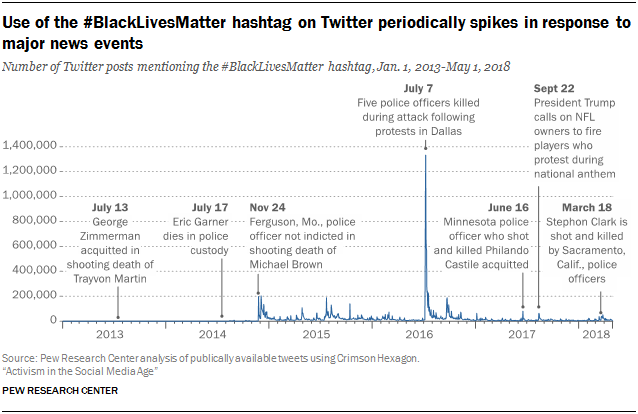
Following these events, each of these hashtags has been used at rates largely in line with their historical averages. From July 18, 2016 through May 1, 2018, the #BlackLivesMatter hashtag has been used an average of 15,856 times daily. The #BlueLivesMatter hashtag has been used an average of 3,998 times daily, while #AllLivesMatter has been used an average of 1,844 times daily.
Beyond #BlackLivesMatter: Differences in the evolution of select hashtags tied to political causes or social issues
The #BlackLivesMatter hashtag is an archetypal example of a hashtag tied to a political issue or cause, and as noted above it has maintained a relatively high baseline level of usage on Twitter over a period of several years. But there are many other hashtags related to various causes, events or political issues, and these hashtags evolve in a variety of ways. As a case study of the ways in which these sorts of hashtags are used on Twitter today, the Center examined five different hashtags (#MAGA, #MeToo, #Resist, #JeSuisCharlie and #LoveWins) to see how their frequency of usage has changed over the years.
The #MAGA hashtag grew increasingly prevalent on Twitter beginning in early 2016, peaking in the days immediately following the 2016 U.S. election in November. From Election Day 2016 through May 1, 2018, the #MAGA hashtag has been used an average of 205,238 times per day. Meanwhile, the #Resist hashtag began to appear as a consistent presence on Twitter shortly following the 2016 election and attained widespread usage immediately following President Donald Trump’s inauguration in January 2017. From inauguration day through May 1, 2018, the #Resist hashtag has been used an average of 59,716 times daily on Twitter.
Although the “Me Too” movement was founded in 2006, the #MeToo hashtag rose to prominence in 2017 and has continued to be used with some frequency following the revelations of alleged sexual harassment and assault by Hollywood prouducer Harvey Weinstein. It was used hundreds of thousands of times on Oct. 16, 2017, as users took to the platform to share their own personal stories of harassment and abuse. From that day through May 1, 2018, #MeToo has appeared an average of 61,911 times per day on Twitter.
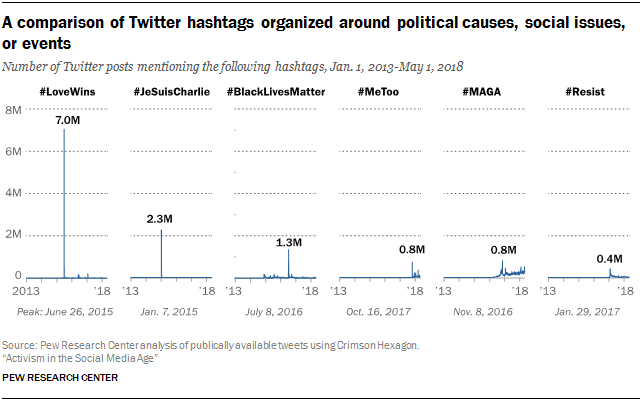
In other instances, hashtags related to an event or cause emerge almost instantaneously, quickly attain immense levels of popularity, and then fade (to varying levels and at varying speeds) from public prominence. One example of this phenomenon is the #JeSuisCharlie hashtag commemorating the Jan. 7, 2015, Charlie Hebdo shooting in France. Despite being essentially non-existent prior to the shooting, #JeSuisCharlie was used roughly 2 million times on Jan. 7 and 8, 2015. But today its presence is relatively minimal outside of anniversaries of the shooting: from Jan. 1, 2016, through May 1, 2018, it has been used on average just 291 times per day.
The #LoveWins hashtag commemorating the U.S. Supreme Court’s June 26, 2015, decision on same-sex marriage is another example of this phenomenon. #LoveWins appeared on Twitter more than 7 million times on the day of the Supreme Court ruling – a figure that dwarfs the largest single-day volume for long-standing hashtags such as #MAGA or #BlackLivesMatter – and again more than 3 million times on the day following the ruling. But those two days alone account for 63% of all the instances in which the hashtag has appeared on Twitter in the nearly three years from the day of the Supreme Court ruling to May 1, 2018.
A case study of topics mentioned in Twitter discussions involving the #BlackLivesMatter, #BlueLivesMatter and #AllLivesMatter hashtags
In addition to examining the volume of tweets using the #BlackLivesMatter hashtag over the last five years, the Center also conducted a separate analysis to understand how often certain topics are mentioned in connection with key hashtags in the broader Twitter conversation around race, policing and fatal encounters involving blacks and law enforcement. To perform this analysis, the Center first queried Twitter’s Gnip API for a 20% sample of tweets mentioning four hashtags related to these topics (the specific hashtags include #BlackLivesMatter, #AllLivesMatter, #BlueLivesMatter and #BLM) during five specific high-volume points in time between 2014 and 2018 that coincided with major increases in the use of these hashtags.
These time periods explore five major news events, including when the Ferguson, Missouri, police officer involved in the shooting death of Michael Brown was not indicted; the police-related shootings of Alton Sterling, Philando Castile and the killing of police officers in Dallas and Baton Rouge, Louisiana; the acquittal of a police officer in the shooting death of Philando Castile; President Trump speaking out about the NFL national anthem protests; and Stephon Clark being fatally shot by Sacramento police officers.
After discarding tweets that were indecipherable or in a language other than English, this data collection produced a corpus of 1,312,385 tweets mentioning one or more of these hashtags during these five time periods. The Center then used a two-step process for identifying whether individual tweets mentioned a particular topic. In the first step, researchers manually examined a small subset of tweets to identify some of the key topics mentioned in these discussions. The identified topics related to these hashtags include:
- Fatal police-related encounters – These tweets mention specific names of people who have had fatal encounters with law enforcement.
- Violent acts in general – These tweets mention specific acts of violence, regardless of whether those occurred in the context of law enforcement.
- Police and law enforcement – These tweets mention police, law enforcement actions, counter-protest measures, and general references to law enforcement. Mentions of shootings or other actions are not included unless they explicitly mention law enforcement or police.
- National politicians and political parties – These tweets mention specific politicians, elected officials, or political parties. Mentions of local politicians or elected officials are not included.
- Race – These tweets explicitly mention race, a particular racial or ethnic group, or racial discrimination. This category does not include references to culture, religion or immigration unless a specific race or ethnicity is mentioned
- Protests – These tweets mention activist events, specific protests or the general act of protesting.
Next, researchers identified a representative set of words and phrases that could accurately identify tweets mentioning each topic and tabulated all of the tweets in the broader data set containing the keywords that are representative of each topic. This allowed the Center to calculate the share of tweets at each individual time period (as well as over these five time periods collectively) mentioning each of these broad topical areas. Please see the methodology section of this report for full details of this process.
It is important to note that these topics are not mutually exclusive, and that tweets can be classified into multiple categories depending on the words used in that tweet. It is also important to note that, as with any coding process, this is not the only set of codes or topics that could be developed and applied to this data set. The goal of this particular project was designed to quantify how often a broad set of topics was being mentioned in a large collection of tweets in a way that could be replicated at scale.
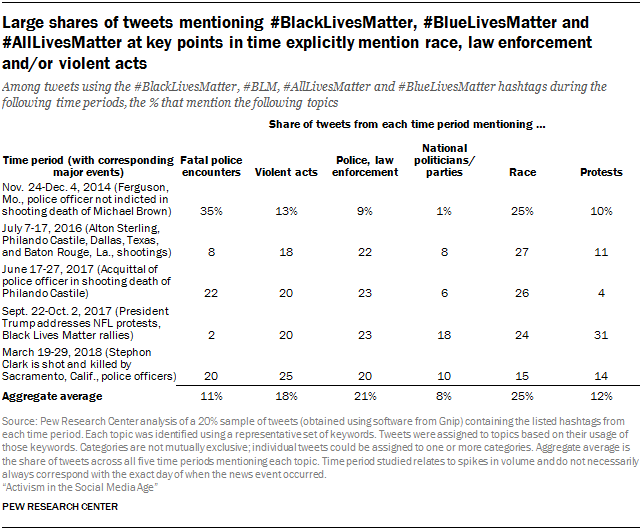
Some of the findings of this analysis are as follows:
Explicit mentions of race and references to law enforcement are the most common topics in this collection of tweets
Of the topics identified in this analysis, three are especially common. One-quarter of the tweets in this data collection explicitly mention race, while 21% mention police or law enforcement. These two topics are closely followed by general mentions of violent acts (whether or not those pertain to law enforcement), which are mentioned in 18% of these tweets. In addition to being the most common topics overall, these three topics are also mentioned at relatively consistent levels across all five of the specific time periods evaluated in the study.
Discussions of protests (mentioned in 12% of tweets), fatal encounters with police (11%), and national politicians or political parties (8%) are somewhat less common overall.
Tweets that mention protests and fatal encounters with police are quite common at certain points in time but less common at others
Discussions related to protests and to specific fatal encounters with police exhibited a great deal of variation in their usage across these five different points in time. Discussions of fatal police encounters were mentioned in 35% of tweets following the announcement that police officer Darren Wilson would not face trial for the shooting death of Michael Brown in Ferguson, Missouri. But this topic was mentioned in just 2% of the tweets surrounding the NFL anthem protests and Black Lives Matter marches that occurred in the fall of 2017. By the same token, discussion of protests accounted for 31% of the discussion during this latter time period.
Mentions of national politicians and political parties are relatively rare, but do make up a large share of the discussion during the fall 2017 time period
For the most part, the tweets in this data collection do not often make explicit references to national politicians or political parties. This topic makes up just 8% of tweets in the overall sample collected for this study. However, there is one major exception: These discussions accounted for 18% of all tweets from Sept. 22-Oct. 2, 2017.

